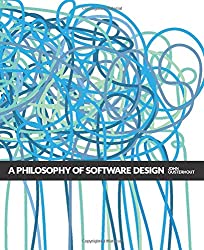“A Philosophy Of Software Design” is a book by John Ousterhout that aims to teach a set of principles by which one can learn how to design software-systems in order to reduce the overall complexity. This is a tall order for a relatively slim book, but I am happy to report that it lives up to its expectations. I had read many good things about the book from people whom I respect, so I was somewhat prejudiced in its favor before I started reading it. That said, almost all practitioners in the field will find something or the other in this book with which they will disagree.
In many ways, this book is complementary to other excellent books in the field like Code Complete and The Practice Of Programming. Unlike those books though, this book spends more time on the higher-level system-design aspects of software than the lower-level coding and debugging aspects. I would recommend any serious programmer to read all these books to get better at their craft.
The book defines “complexity” as “anything related to the structure of a software system that makes it hard to understand and modify the system”. I think this is quite a reasonable definition of the term. Most experienced programmers would agree that their designs and implementations should aim to minimize the complexity of systems. The book then goes on to show how to identify the symptoms of complexity and what causes it. It recommends following a “strategic programming” approach while building a system as opposed to the “tactical programming” approach often seen with inexperienced programmers, start-ups scrambling to get to an MVP, projects working under tight deadlines, etc. It recognizes that the former approach is not always feasible, so it suggests ways in which one can find the right balance.
The bulk of the book is devoted to demonstrating techniques that can help reduce the complexity in a system. Some of these run directly against the conventional wisdom in certain pockets of our industry. For example, the author strongly recommends that a module should be “deep” – a small interface that presents a good generic abstraction over a large and possibly complex implementation. The author presents the well thought out, yet quite small, interface for file I/O in Unix and contrasts that with rampant “classitis” in Java. As another example, the author presents the copious exceptions that are bubbled up across the call-stack in many Java programs and contrasts that with an approach that minimizes or altogether eliminates certain classes of errors. The author recommends that the designer of a module should “pull the complexity downward” in order to shield the users of the module from the complexities of implementing the relevant abstraction (contrast this with the “Worse Is Better” approach).
The author offers several pieces of advice for quotidian activities that nevertheless impact the complexity of a system. These include when and how to write comments, how to choose good names, making code more obvious, eliminating certain classes of comments, ensuring consistency while modifying code, etc. I believe most reasonable programmers would agree in general with the advice in these chapters, except possibly for the “eliminate all comments” extremists.
On the other hand, the author also offers several opinions on many software-trends like object-oriented programming, agile development, test-driven development, design-patterns, getters and setters, etc. These opinions are sure to rile up some of the readers, although I must admit that I ended up agreeing with almost all of them. Our industry suffers too many fads and entertains far too many charlatans who mislead impressionable young programmers into wasting their time and effort.
There are several design-principles and red-flags throughout this book (helpfully gathered in a concluding summary towards the end of the book) that would be useful for new and experienced programmers alike. I would heartily recommend this book to inexperienced programmers serious about their vocation, though they might not appreciate it fully straight out of college. Even for experienced programmers and system-designers the book nicely articulates several principles and perspectives that they might have internalized over time. I have been gravitating towards many of these principles over the years myself, so it is nice to have a well-written book to which I can point others as a nice summary of such principles.
This book deserves to get a prominent place on the bookshelf of every serious programmer. I would be sure to keep returning to it in the future.
